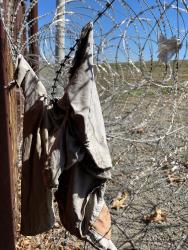
On September 19, I was part of a group of sixteen people from Westminster Gardens, a senior community in Duarte, who set out for San Ysidro to visit the Daniel F. Romero Center for Border Ministries and Strategies (Centro Romero). This organization was established by the United Church of Christ in 2007 with locations in San Ysidro and Tijuana. The vision for the center was that of Dan Romero, a minister and attorney, who spent years offering his services to the work of the center—and still does in his “retirement.” He received the honor of having the center named for him. And I must add that I am privileged to have him as a neighbor and friend.
Dr. C. J. Correa, Executive Director of the Romero Center, welcomed us to the San Ysidro location. We learned about the work of the center, which addresses critical issues affecting the lives of those living in the communities situated in the border region. The center provides social services to the needy in the Tijuana border area and helps those at the border waiting to immigrate to the United States. The center distributes protein packs to the food-deprived, offers “loads of love” coins that can be used at a local laundromat, and sponsors a “mercy program” to build small houses for unhoused individuals who are awaiting immigration approval. One church has already donated enough money to build the first small house. In addition, the San Ysidro Center has temporarily housed some in critical need.
Dr. Correa reminded us that few relationships matter more to the United States than that with Mexico. “The two countries share more than a border—they are bound together by shared challenges for the prosperity, security, and well-being of their citizens.” The U.S.-Mexico border extends nearly 2000 miles from the Pacific Ocean to the Gulf of Mexico, passing through some of the most inaccessible and desolate countryside in North America. The San Ysidro Port of Entry is the busiest international land-border crossing in the world. One in ten people entering the United States enters through the San Ysidro Port of Entry.
We went to see the border wall, which we viewed from a shopping center on the San Ysidro (U.S.) side. Mexican citizens can get a pass that allows them to cross the border at a specific time to shop at the mall. Border Patrol officers guard the crossing, and the border fencing is a reminder that not all are welcome. Cameras record attempts at illegal entry, and the barbed wire ensures that anyone making such an attempt will suffer. In one of the photos I took, clothing caught in the barbed wire offered a reminder of that suffering—and of the extreme motivations for taking a chance at illegal entry.
My takeaways from the trip:
- We must educate ourselves and spread the word about the needs of thousands of people awaiting entry to the United States, including the severe conditions that lead to their migration.
- The centers and the migrants they serve are fortunate to have a dynamic, caring, effective, and recognized leader like Dr. Correa (Carlos), who has remained steadfast in his support of all who are in need.
- The digital application for entry to United States requires internet access (a smartphone or computer) and is confusing, complicated, and nearly impossible for many to complete without the help of a professional such as an attorney. Migrants who manage to complete the digital application must then have it reviewed by a Border Patrol guard, who may determine it to be inadequate in demonstrating the migrant’s “credible fear” of persecution in the country of origin.
- Finally, we in the League must keep reminding ourselves that immigration reform is critical, and our current inadequate system is damaging lives as we speak. The effort to reform our immigration laws, increase the safety and efficiency with which migrants are processed at the border, and welcome those whose contributions to our country are likely to meet or exceed the promise of the American dream they hope to fulfill must not be lost among the many other issues that Congress is (or is not) addressing.
To that end, it is incumbent upon each of us to become informed about the bills awaiting action, such as Senator Alex Padilla’s bill to broaden lawful pathways to citizenship, which would expand opportunities for to permanent resident status and citizenship for millions of long-term U.S. immigrants. We also need to support the Dream Act, which would ensure legal status for DACA recipients.
To get involved, please contact Katherine Gavzy, who is a member of LWVC (state) Immigration Interest Group, at katherinegavzy [at] lwv-pa.org.
—Dorothy L. Keane